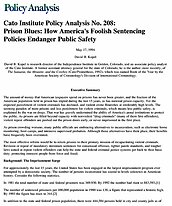The amount of money that American taxpayers spend on prisons has never been greater, and the fraction of the American population held in prison has tripled during the last 15 years, as has national prison capacity. Yet the expected punishment of violent criminals has declined, and violent crime flourishes at intolerably high levels. The seeming paradox of more prisons and less punishment for violent criminals, which means less public safety, is explained by the war on drugs. That war has gravely undermined the ability of America’s penal institutions to protect the public. As prisons are filled beyond capacity with nonviolent “drug criminals” (many of them first offenders), violent repeat offenders are pushed out the prison doors early, or never imprisoned in the first place.
As prison crowding worsens, many public officials are embracing alternatives to incarceration, such as electronic home monitoring, boot camps, and intensive supervised probation. Although those alternatives have their place, their benefits have frequently been overstated.
The most effective reform would be to return prisons to their primary mission of incapacitating violent criminals. Revision or repeal of mandatory minimum sentences for consensual offenses, tighter parole standards, and tougher laws aimed at repeat violent offenders can help the state and federal criminal justice systems get back to their basic duty: protecting innocent people from force and fraud.

This work is licensed under a Creative Commons Attribution-NonCommercial-ShareAlike 4.0 International License.

